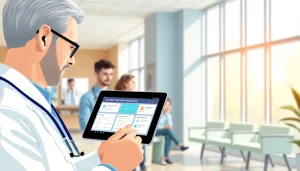
What is E-Prescribing?
Definition and Overview
E-prescribing, short for electronic prescribing, is a technologically advanced system that allows healthcare providers to send prescriptions directly to pharmacies electronically. This method replaces traditional paper prescriptions, enabling a more streamlined and secure way of managing medication orders. With e-prescribing, healthcare providers enter prescription information into a computer, which is then transmitted electronically to the pharmacy chosen by the patient. This innovative approach improves the efficiency of the prescribing process, minimizes errors, and enhances patient safety.
The convenience of e-prescribing is not just limited to the healthcare provider. Patients benefit as well, receiving their prescriptions promptly and without the need to carry paper documents. E-prescribing also allows for real-time access to a patient’s medication history, ensuring that providers make informed decisions about treatments based on current prescriptions.
History and Evolution of E-Prescribing
The concept of e-prescribing emerged in the late 1990s, coinciding with advancements in health information technology. Initially, healthcare providers faced challenges due to a lack of interoperability between systems. However, as electronic health records (EHRs) gained prominence, e-prescribing became integrated into these systems, allowing providers to send prescriptions more efficiently.
By the early 2000s, various states in the United States began implementing regulations to promote e-prescribing. This push was further supported by incentive programs from the government aimed at increasing the adoption of electronic health solutions. The integration of standardized formats and protocols for e-prescribing has significantly improved its usability and reliability over time.
Importance in Modern Healthcare
Today, e-prescribing is recognized as a crucial component of modern healthcare delivery. It fosters improved communication between healthcare providers and pharmacies, reduces the risk of medication errors, and contributes to better patient outcomes. With an increasing emphasis on patient safety and quality of care, e-prescribing has emerged as an indispensable tool in the arsenal of healthcare technology. The how does eprescribing work is continually evolving to meet the demands of providers, patients, and regulatory bodies.
How Does E-Prescribing Work?
Step-by-Step Process
The e-prescribing process can be broken down into several key steps:
- Patient Visit: The process begins when a patient visits a healthcare provider for an assessment or consultation. During the visit, the provider evaluates the patient’s condition and determines if medication is necessary.
- Prescription Entry: Instead of writing a paper prescription, the provider enters the prescription details into the EHR system. This includes the drug name, dosage, instructions, quantity, and any refills needed.
- Review and Send: Once the prescription is entered, the provider reviews it for accuracy and then sends it electronically to the selected pharmacy. This transaction is securely transmitted, usually via a health information network.
- Pharmacy Receipt: The pharmacy receives the e-prescription and processes it through their system. Pharmacists can check for any potential interactions with existing medications and address any clarifications needed with the provider.
- Patient Notification: Once the pharmacy has filled the prescription, they notify the patient, who can then pick it up or have it delivered, depending on the pharmacy’s policies.
Technology and Software Involved
E-prescribing relies on various technologies and software systems to function effectively. Here are some of the technological components involved in the process:
- Electronic Health Records (EHR): EHR systems are the primary platforms for entering and managing patient data, including prescriptions. They serve as the backbone for e-prescribing, offering features that enhance workflow and integration with pharmacies.
- Scripting Software: This software allows for the creation of e-prescriptions. It often includes features to ensure compliance with regulations, drug interaction alerts, and user-friendly interfaces for healthcare providers.
- Health Information Exchanges (HIEs): HIEs facilitate the secure exchange of patient information across different healthcare entities, including pharmacies, ensuring that relevant prescription information is available at the point of care.
- Data Security Measures: Given the sensitive nature of healthcare data, e-prescribing systems are equipped with robust security features, including encryption and secure access protocols, to protect patient information.
Roles of Healthcare Providers and Pharmacies
The successful implementation of e-prescribing involves collaboration between various healthcare stakeholders:
- Healthcare Providers: Physicians, nurse practitioners, and other providers are responsible for entering and sending prescriptions electronically. They must also ensure that they stay updated on the latest protocols and use e-prescribing systems effectively.
- Pharmacists: Pharmacists play a critical role in validating and fulfilling e-prescriptions. They ensure the accuracy of the services provided and handle any patient inquiries regarding prescriptions.
- Healthcare IT Specialists: IT professionals support the installation, management, and troubleshooting of e-prescribing systems, ensuring compliance with regulations and maintaining data security.
Benefits of E-Prescribing
Improved Prescription Accuracy
One significant benefit of e-prescribing is the marked improvement in prescription accuracy. By eliminating handwriting errors and misinterpretations, healthcare providers can minimize medication mistakes that could jeopardize patient safety. E-prescribing systems typically include built-in checks that alert providers to potential drug interactions and allergies, further enhancing safety.
Increased Patient Safety
Increased patient safety is a prominent concern within healthcare. E-prescribing enhances safety by providing a comprehensive view of a patient’s medication history, allowing providers to make informed decisions. This interconnectedness between providers and pharmacies helps ensure continuity of care and appropriately addresses any issues that may arise concerning individual medications.
Cost and Efficiency Advantages
E-prescribing also offers considerable cost advantages and efficiency improvements. With reduced paperwork and streamlined workflows, healthcare providers can save time and resources. Pharmacies benefit from fewer callbacks to providers for clarifications, allowing them to allocate staff efforts toward patient-facing activities. Additionally, patients can save money through improved medication management and adherence, ultimately leading to better health outcomes and reduced healthcare costs.
Challenges and Considerations
Privacy and Security Risks
Despite its numerous benefits, e-prescribing does present challenges, particularly concerning privacy and security. The electronic transmission of sensitive patient information raises concerns about unauthorized access and data breaches. Healthcare organizations must implement robust security protocols, including data encryption and regular audits, to safeguard patient information against potential threats.
Integration with Existing Systems
Another challenge lies in the integration of e-prescribing systems with existing health information systems. Healthcare organizations must ensure that these systems are compatible and can communicate effectively with one another. Gaps in this integration can result in inefficiencies and potential data inaccuracies that undermine the value of e-prescribing.
Provider and Patient Adoption Rates
The adoption of e-prescribing technologies varies among providers and patients. Some healthcare practitioners may be resistant to changing established practices or may require additional training to use e-prescribing systems effectively. Similarly, patients accustomed to traditional methods may take time to adapt. Addressing these resistance factors through training and education is essential for improving adoption rates and reaping the benefits of e-prescribing.
Future Trends in E-Prescribing
Advancements in Technology
As technology continues to advance, e-prescribing is expected to benefit from innovations such as artificial intelligence and machine learning. These technologies can help enhance decision-making by providing predictive analytics based on patient data, further improving medication safety and efficacy. Integration with telemedicine platforms may also enhance e-prescribing by allowing providers to prescribe medications during virtual visits seamlessly.
Potential Regulatory Changes
Regulatory bodies are likely to continue refining policies governing e-prescribing. Future regulations may emphasize increased usability standards, interoperability, and reporting requirements aimed at improving healthcare delivery. Adaptation to these changes will be essential for healthcare organizations striving to maintain compliance and ensure best practices in e-prescribing.
Impact on Patient Care
The impact of e-prescribing on patient care is profound. As systems become more widespread and integrated into everyday healthcare practices, patients stand to benefit from more reliable medication management, enhanced communication with providers, and a more streamlined healthcare experience. These improvements are anticipated to lead to better health outcomes, increased patient satisfaction, and overall elevated standards of care within the healthcare system.






